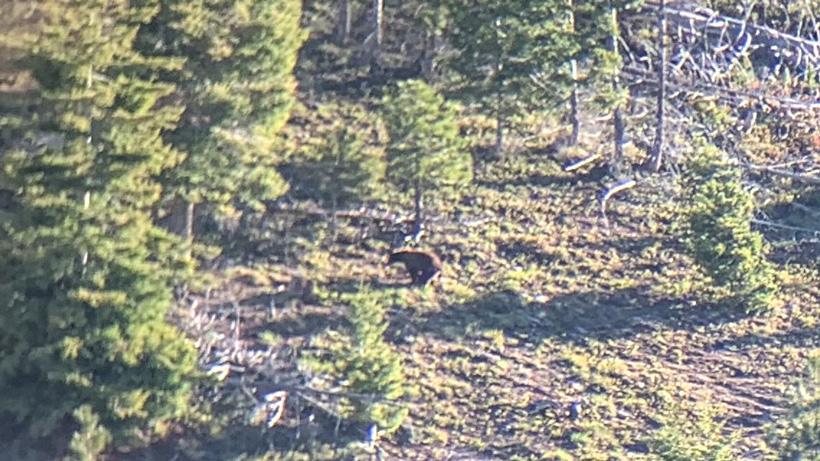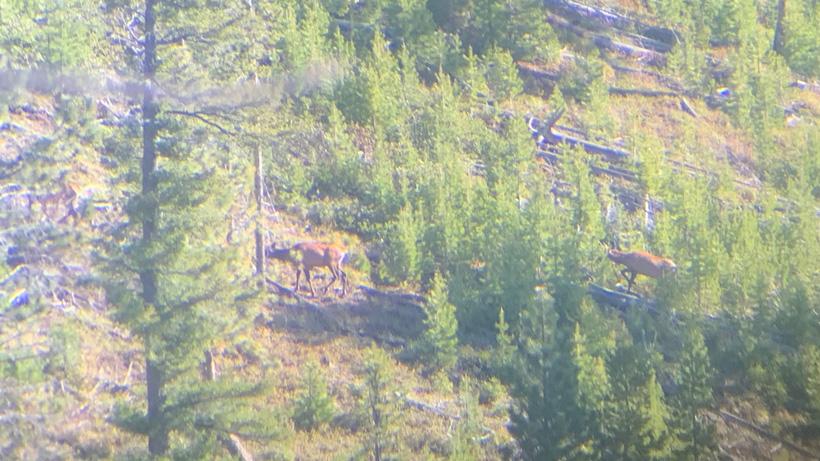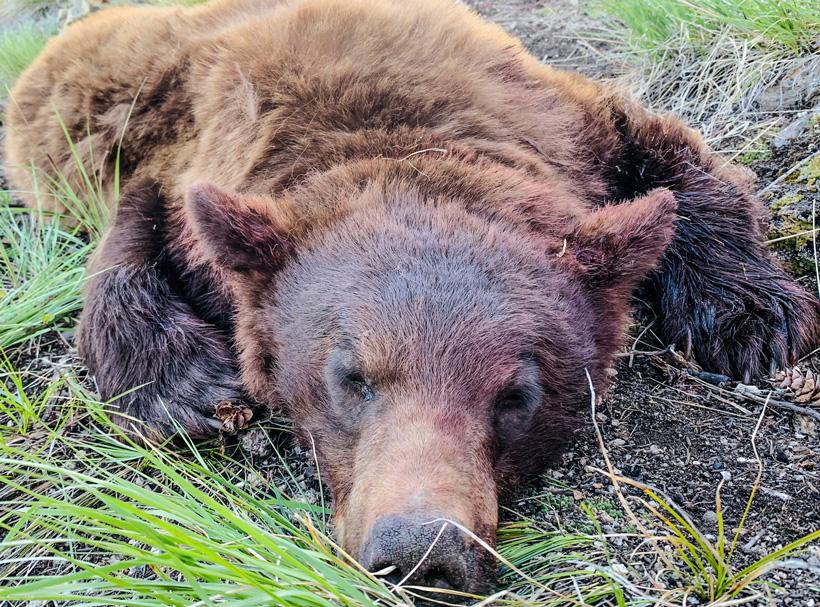








All photo credits: Scott Ergas
In late May—when the scissors of spring have cut through winter’s ribbons and blue skies adorn lively hillsides—you’ll find me on high vantages observing the pulse and taking inventory of the happenings of spring black bears.
This particular drainage had a lot of positive geographical features I tend to hone in on for spring bear hunting. The natural topography serves as a game funnel with a southeast aspect and a cliffed-out, year-round creek that leaks to the valley floor below. The contours shift perfectly from an old burn to a barren bitterbrush transition zone to dark timber allowing for a nice sequence of habitat in any direction for all animals going about their business—the first time I saw it I thought, “There’s surely a bear using that terrain, I’m going hunt it.”
We carefully caravanned up to the spot we had planned to make camp and arrived a little later than anticipated. Full of eagerness to break the seal on our own “hunter’s hibernation,” we propped our tents up and gathered firewood in quick fashion. Sunset was in its early stages, dappling the draw across from us with slivers of fading light as clouds overhead bobbed and weaved their way across the landscape. We decided to glass until dark.
I stood there, holding my 9x45 binoculars. No more than three minutes passed before I caught radiant color and movement across the canyon. It was a mature color-phased cinnamon with a swagger, sauntering by. I was mildly disappointed because it happened so quickly. The hunt had hardly begun, but it wasn’t a specimen to pass up. I hastily fetched some of my gear: rangefinder, a puffy coat for a rear rest, rifle and bipod. My gut instinct about the area gave me a quiet confidence and subtle validation after spotting the bruin. My buddy and his son were now glassing the hillside up as well, following the boar’s movements while I fumbled around and struggled to get a yardage range on him.
To my relief, the bear walked into a lone patch of trees in the middle transition area and I verified with my hunting party that no one had seen it squirt out on the other side of the pine pocket. It was on the brink of dusk and I felt strongly that it had bedded up. The game plan was to get a good night’s rest and be glassing up that situational oasis at first light. For as giddy as I was, I managed to sleep like a rock.
I tucked away on a rocky glassing knob across from his patch before dawn arrived, filled with anticipation and fervor. A sneaky suspicion told me that if the boar was in there and as soon as the sun crested the mountains to the east of us, the hillside would illuminate and heat up, shaking the bear loose from its slumber. To my surprise, this turned out to be accurate as I watched it emerge from its shielded enclave and bask in the sun for a little while. In case anyone was pondering the answer to the age-old question, “Does a bear poop in the woods?” The answer is yes.
After relieving himself, he rummaged about for a short spell, disappearing into the tree patch for a half hour before starting off uphill and further away from my position. I glassed him as he tramped purposefully into the dark timber on top of the ridge and out of sight. If the bear had gone downhill towards the creek, it would have brought him into a range distance I was more comfortable with and I would have taken the shot. Alas — this wasn’t the case.
I desperately wanted to know what was in that tree patch; we all did. Maybe it had a Sealy Posturepedic mattress cached under some tree boughs with some Edison bulb lights hanging overhead. A bear bachelor pad — it’s anybody’s guess. It’s fun to speculate, but I didn’t want our curiosity blowing him out by spreading human scent.
Bears can have multiple day beds that they access and utilize periodically. I felt that if this bear was on a tight program then he would be back at some point later in the day. We decided to cut the distance by about 200 to 250 yards, dropping elevation and then regaining it while boomeranging around this draw to another vantage point that I suspected would have a better line of sight to his hideout, a favorable wind and an equally desirable shooting lane. I was banking on the bear’s routine being its fatal flaw.
We made it over to the next perch by 2 p.m., ate a bite and took a nap for an hour. I was the only one with a bear tag, so this rodeo was sort of mine to ride out and I was hopeful it didn’t turn into a circus. We glassed and gridded—nary a peep. Finally, we caught movement in the form of some cow elk crossing the transition zone constantly looking uphill and on guard.
They slowly ventured via the side hill and were extremely leery. This made me think the bear could be very near or that they had previously been harassed by it on this hillside. Nothing came of it and the elk made their way to wherever they were going. I began to wonder if the bear had skedaddled out of our lives.
But at 5:17 p.m., I caught a flash of color barreling down diagonally at a six to seven mph clip. Head low and on a mission—it was him, no doubt.
“There he is!” I said to my pals. We all keyed in on him and I kept leading my glass ahead of his course, thinking perhaps I wasn’t seeing something or he was in the middle of a predatory pursuit, but I couldn’t make heads or tails. I witnessed him put the brakes on and flop down. This was a peculiar sequence. He was in the area behind the tree patch that we couldn’t observe in the morning. It looked as if he was gnawing on a downed log — maybe for grubs — and kept raising his head and then burying it into the end of the log. He wasn’t bedded and wasn’t standing either. Instead, he was in a trance, giving me vitals.
I set up a good rear rest armpit wedge and propped my backpack vertically in between my butterflied legs — a shooting position I now refer to as “criss-cross special sauce.” He was in my scope for a good 15 minutes without shifting his contour, preoccupied and consistent. I knew I could slip one into him. I turned to my buddy’s son and asked him to get his ear protection on and confirmed with my pal that he was going to track my shot in his binos. Thumbs up!
My breathing was slowed to a euphoric pace as I chambered a round and clicked the safety off. The shot rang out and it felt good. I was slightly bucked out of the scope, but was able to rebalance to see the finality of movement. My buddy said, “That’s a dead bear, rolled 10 feet and hasn’t moved.” Eager to get over there and inspect the situation, we packed our gear and started the hike up the draw. Why would a bear be so eager to get back to chew on a log? Did he miss lunch while we didn’t see him for those eight hours?
After getting up to the scene, we could see what we couldn’t see from our angle. Behind the log was a fresh kill of his, meat still wet and he wasn’t gnawing on the end of the log, (by the looks of it, he might have been doing that too) but he was snout deep in a rib cage. Those elk a short while earlier were likely on guard and that bear was not going to give a meal away to any usurpers. It all made sense!
It’s a visceral and cathartic feeling to be an honorary spoke in the circle of life cog. Spring bear hunting can be a testament to the cyclical nature of everything and the importance of balance. Just as current seasons depart — and new life is breathed into the landscape — a formidable challenge awaits and adventure continually persists.